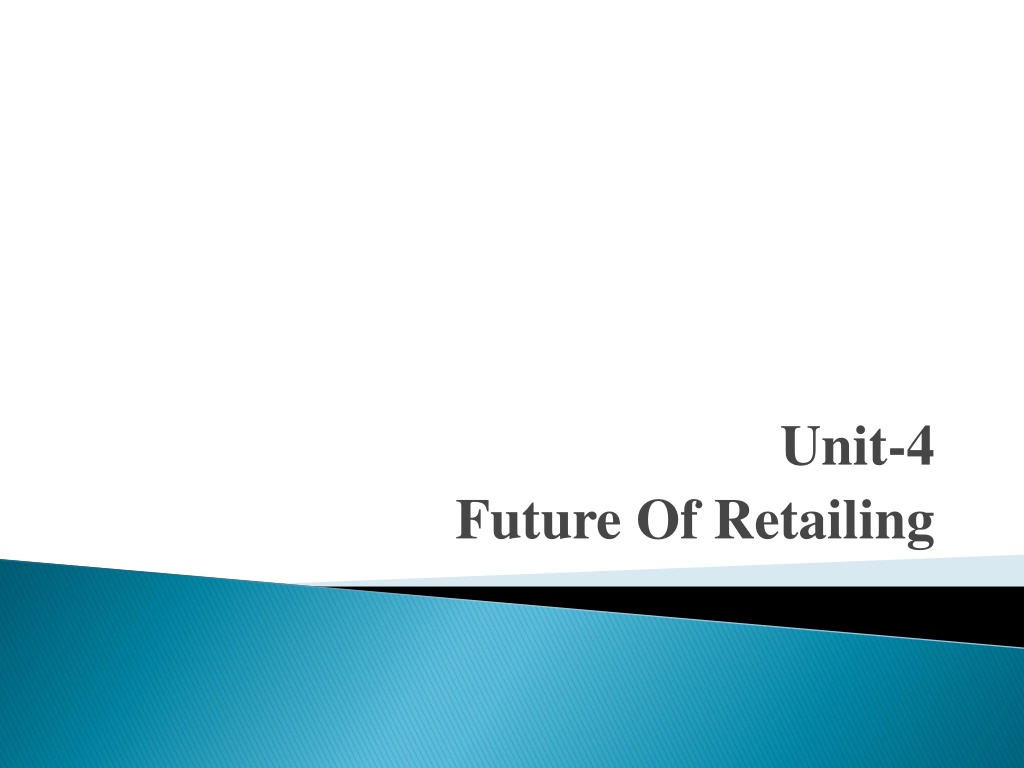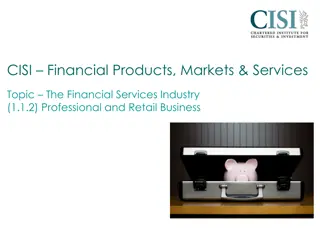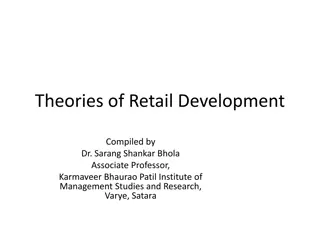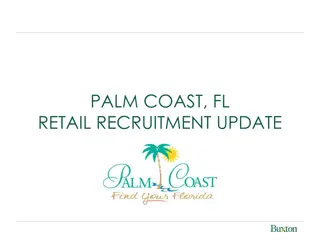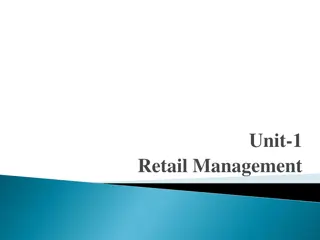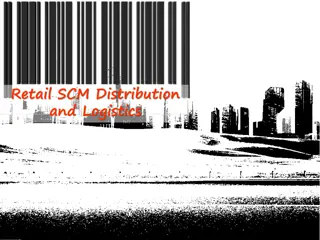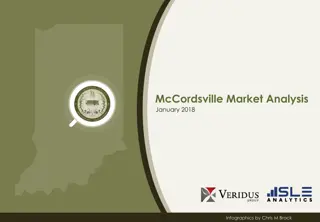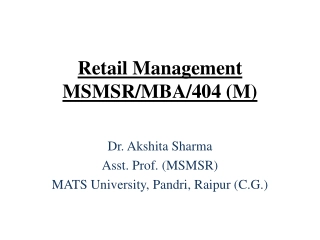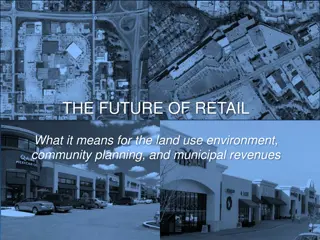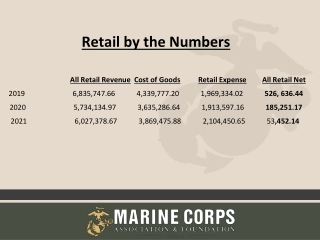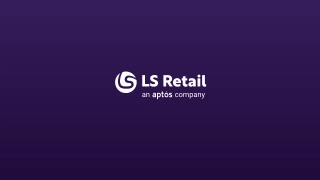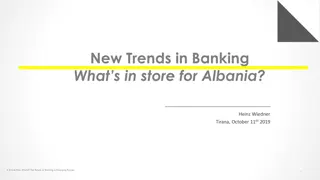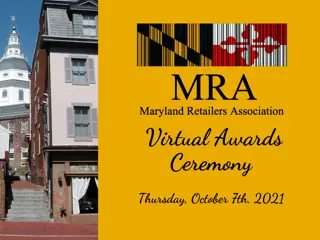Emerging Trends in Retail Industry: A Glimpse into the Future
The retail industry is evolving rapidly with advancements in technology shaping the consumer journey. From omni-channel retailing to hyper-personalization and AI integration, businesses are adapting to meet the demands of tech-savvy customers. The shift towards multi-channel retailing is blurring the lines between physical and online stores, offering a seamless shopping experience. Discover the key trends influencing the future of retail and how businesses can stay ahead in this dynamic landscape.
Download Presentation

Please find below an Image/Link to download the presentation.
The content on the website is provided AS IS for your information and personal use only. It may not be sold, licensed, or shared on other websites without obtaining consent from the author. Download presentation by click this link. If you encounter any issues during the download, it is possible that the publisher has removed the file from their server.
E N D
Presentation Transcript
Unit-4 Future Of Retailing
Contents:- Introduction to recent trends and Technological Advancements in retailing Omni Channel Retailing shopping with AR(Augmented reality) Pop up shops social shopping private label brands
Technology is an ever-changing playing field and those wanting to remain at the helm of innovation have to adapt. The consumer journey is charting a new course and customers and companies alike are embracing emerging technologies. As the IT industry trends such as cloud computing and SaaS become more pervasive, the world will look to brands who can deliver with accuracy and real-time efficiency.
To help meet the demands of a technology-enabled consumer base, businesses and solution providers must also turn toward the latest trends and possibilities provided by emerging innovations to realize their full potential. But, where to begin? These are the emerging trends businesses need to keep their eyes on in 2020.
Trends Shaping The Future Of Retail Industry Automated Inventory System Redefined In-Store Innovation: * No check-in and check-out counters * Innovation Digital Kiosk * Virtual Fitting Rooms Hyper-Personalization Artificial Intelligence Hyper-local Retailing 1. 2. 1. 2. 3.
Omni channel retail is a business model in which all existing channels become completely integrated to offer customers a seamless shopping experience. This Omni channel retail strategy is empowered by centralized data management, which means that the distinctions among channels, both physical and online ones, are blurred. As a result, customers can simultaneously use different channels in their shopping process, starting their search at a channel and finish the purchase in another one. They are given chances to create their own preferable shopping routines, which seems to be more attractive to a new generation of consumers in the 21st century. It s noteworthy that Omni channel retail approach can be adopted simultaneously in sales channels, inventory management, and marketing strategy.
A shift from single-channel to multi-channel retailing Single-channel Multi-channel
single-channel is the traditional retail model. It focuses on one sole channel sale based on the single-distribution system. The retailers own only brick-and-mortar stores (offline) or web-stores (online). Initially, this model achieved a lot of accomplishment because focusing on a single channel might minimize all expenses as well as drive sales growth. Moreover, if a provider dominated a market for their product or service, a single-channel strategy could help them keep that control. However, one channel sale encountered many limitations as the age of digital came and many more sale channels arose. Customers expected a more convenient experience and used multiple channels as well as multiple devices and platforms.
As a result, a single-channel strategy is no longer enough to attract increasingly demanding customers. That put retailers under a pressure of reshaping their store management work as well as business models for fear of lagging behind in the sale- growth race. At that moment, multi-channel arose as a new retailing approach that could take advantage of the digital age to satisfy customers with whatever channels they chose. This business model quickly dominated the retail industry and continuously developed.
Multi-channel retail is a business model born with the digital revolution. Retailers adapting this strategy offer customers a choice of ways to purchase their products, via both online and offline channels. Therefore, it s more flexible and convenient for consumers to purchase goods or services, which helps dramatically boost sales. Another advantage of this strategy is that it brings about a 24- hour access to customer, which helps build brand loyalty. Retailers also benefit from multi-channel by improving analytics to understand consumer behaviours since building a personalized customer experience is a must in the digital age. However, many questions had risen along with the expanding of multi-channel retail, including how to bring customers a seamless experience across channels and which could help smoothly operate the internal process.
As customers had become more demanding, fulfilling their expectation went beyond retailers infrastructural development. Creating a seamless experience over different channels, while at the same time ensuring the accuracy and efficiency, was almost impossible. For example, retailers found it hard to manage purchases from various channels or struggled with order fulfillment and speedy delivery. Besides, customer service was also a big concern since retailers communicated with shoppers in multiple channels and became confused with data synchronization in separate systems. Multi-channel adopting retailers also encountered problems related to the internal process. Supply chain must be the first and the most important matter to be mentioned.
More channels involved in the distribution system required more available warehouses with higher inventory accuracy, whereas multi-channel strategy lacked inventory visibility and an efficient multi-warehouse management. That caused a supply- demand gap that was almost impossible to be closed without a centralized management system. Furthermore, this business model also caused difficulties in measurement analysis when collecting data from separate channels, leading to an inefficient strategy. As the retail landscape continued to change and multi-channel seemed to reach its limitation, the retail world moved forwards a new phase called Omni channel retail model. Omni channel retail optimizes multiple sales channels while at the same time brings about a high level of integration among them.
Augmented reality in Retailing: Augmented Reality is one of the biggest technology disruptions that have blurred the lines between virtual world and the real world. AR turns the environment around you into a digital interface by placing virtual objects in the real world and in real time. AR has an ability to present a real-life environment right in front of you such as kids playing football, trees swaying in the park, and animated characters like-Alladin flying in skies on his magic carpet - with a digital augmentation overlaid on it. The physical real-world environment is superimposed with computer generated images, graphics, audios and other sensory enhancement thus changing the perception of reality.
The brief history of Augmented Reality: In 1968 Ivan Sutherland created the first head mounted display called the Sword of Damocles, This paved the way for the AR we use today. The term Augmented reality was first coined in the year 1990 by Boeing Researcher Tom Caudell. In 1992 Louis Rosenberg created the first fully immersive AR system at the U.S Air Force Research Laboratory. Augmented Reality was first used in 1998 for navigation, in NASA s X-38 spacecraft. During the year 2016 Niantic and Nintendo launched Pok mon Go-the hugely popular location based AR game that put AR on the mainstream map. Now-a-days augmented reality has been adopted by almost every Industry ranging from manufacturing, healthcare, education, construction, retailing, entertainment and media. Retail companies across the world have realized the importance and benefits of AR and therefore absorbed this technology on their physical as well as online channels.
Various ways in which Augmented Reality is transforming Retailing: Over the years there has been various dynamics that have changed the way retail business operates today. New and emerging technology, hyper competitive environment, changing customer behavior and startup driven ecosystem has incredibly changed the way retailers sell and customers shop. Forward- thinking firms are using AR apps throughout the customer journey to generate more dellghtful interactions with their users. 1. AR enhances customer communication 2.Try-as-you buy experience 3. creates a personalized shopping experience 4. AR improves In-store shopping experience 5. Overcome the space limitations of a traditional store shelf
Pop-up shops are popularly known by several other names like temporary retail, flash retailing and pop-up stores. Pop-up shops have become a popular model of retailing in the recent years and are said to be the extension of online stores. A Pop-up shop is a temporary storefront space operated usually by the online retail firms. These stores may look like a regular store, but many retail brands use them to create a unique and innovative way of engaging customers through physical shopping experience. Online retail brands often use Pop-up stores to help them decide whether exploring the world of offline sales makes sense for their particular business, without having to make the long term financial commitment of a fully equipped permanent storefront. The concept of Pop-up stores was first introduced in the early 199 0 s in large urban cities of London, Los Angeles, Paris, and New York City.
Benefits of Pop -up Stores: 1. Pop-up stores offer multichannel shopping experience: In this hyper competitive business environment retailers need to stay ahead. Therefore retailers always find out creative and innovative ways to attract, engage and win customers. Pop-up stores provides online retail firms an opportunity to engage customers through both online and offline channels. Retailers get in touch with the customers through multichannel retail platform. The stores allow retailers to engage customers with product demonstration and give customers an opportunity to try the product physically. A retailer can overcome the limitation of online store by offering products through offline stores.
2. Pop-up stores are cost effective: o Pop-up stores are short term retail stores and thus need less investment on infrastructure and other overhead cost as compared to traditional retail stores. o Pop-up stores are smaller in size and therefore rental rates become far more reasonable. o Traditional retail stores are typically owned or are taken on rental basis for a period spanning from 3 years to 10 years. But pop-up stores have a shorter life span anywhere from 3 days to six months due to which retailers need less investment in resources. o Pop-up stores are temporary in nature, so the retailers tend to stock limited amount of inventory. That means retailers do not need extra storage space for stocking inventory.
3. Retailers can explore new market opportunities: As Pop-up store requires smaller financial commitment, retailers can take this as an opportunity to explore new market places as well as finding new customers for their store. With exploring new markets for their store, retailers can simultaneously create Brand awareness and brand visibility for their store. Instead of getting customer closer to the store, the retailer can come closer to the customer by setting the Pop-up store nearer to the locality of the customer.
4. Creates Brand Awareness by generating buzz: New generation customers are experimental and always waiting for surprises and excitement. One of the primary benefits of Pop-up store is that they help retailers create brand awareness for their store by generating buzz around the brand. Pop-up retail format is a creative way to attract customers towards the store by drawing their attention towards various promotion messages. Retail firms create buzz around the brand by sharing location of the store on social media, developing eye catching signage to welcome strolling shoppers and creates an environment that will make customer want the same experience again and again.
5. Pop-up stores offers unique shopping experience: Pop-up stores are not confined to the four walls like the traditional retail stores. They have a scope to explore new markets and always search an opportunity to be visible for their customers. Pop-up stores harness the power of experiential marketing and try to create a unique and seamless shopping experience for their customers. Today shopping is not just about visiting the store and buying products, but rather modern retailers are creating a more exciting and experiential buying journey for their customers. Consumers are now more likely to remember and engage with your brand if they re able to associate it with a fun experience or event. It s more about connection and personal relationships than simply being present.
Social Shopping Introduction Social Shopping is a crossroad between social media and ecommerce. Social Shopping is a part of shoppers entire purchase journey. It starts at a very initial level of consumer buying journey, when he/she is in a research mode of finding the best suitable product that will satisfy his/her needs, Social Shopping is an act of using social media to find out the likes, comments, reviews, and recommendation that a specific product or a brand has received and then taking that as a base to decide whether to buy or not to buy. Gone are the days when social media platform was basically used for sharing photos, getting to know people around the world, making new friends and connecting to the old ones. Social Media has created a wider platform for the users which includes photo sharing, blogging, social gaming, social networks, video sharing, business networks, virtual worlds, reviews and much more. Even governments and politicians utilize social media to engage with constituents and voters.
According to a Dive report, 72% of Instagrammers say that they have made purchases after seeing something on the platform, which means customers, would like to buy in-app. Since followers use social media platforms to find new products, customers buying directly from social media stores save time and make impulse purchases. Retailers are exploring new ways to reach customers. Social Media has become one of the very popular platform that is increasingly been used by the retailers to attract and create customer engagement. According to Forbes research study, nearly 25% of business owners are selling through Facebook and 40% are using social media as a whole to generate sales. Not only does social media influence what people buy through recommendations (23%), a fully 30% of consumers say they would make purchases through Pinterest, Instagram, Twitter, or Snapchat.
Social Shopping is a juncture point where social media and commerce meet together. It is a way to improve the efficacy of social media ads for brands and at the same time streamline the buying process. Let us take an example to understand social shopping better. Riya purchased a T-Shirt from an instagram store after he friend recommended the same to her. Satisfied with the product quality and the service of the online store, she recommended another friend to visit the same shop online. And the loop continued. In simple words, it is the process of simplifying how customers buy a product online while increasing the effectiveness of social media ads for brands. While earlier, the measure of word-of-mouth (WOM) publicity was limited to family members and friends of an individual, the emergence of social media has significantly expanded this measure. Digital Word Of Mouth (DWM) has become a popular tool in social shopping to attract and engage customers.
Private label brands Private label brands (or own brand labels) are products sold by a retailer with its own packing, but manufactured by a third party. For example, Tesco sell ordinary branded items, such as Heinz baked beans, but also sell their own Tesco Value baked beans. Tesco will license a manufacturer to produce baked beans and then sell the product with it s own label. The big advantage of private label brands is that they do not include specific marketing costs; also, if a supermarket has an exclusive deal, average transport costs can be lower and they can benefit from distributional economies of scale. Because of the lower costs, the supermarket can sell the product at a lower price, but also gain a bigger profit margin.
Definition of Manufacturer owned brand: P. Kotler, G. Armstrong, V. Wong & J. Saunders (2008) defines manufacturers owned brand as A brand created and owned by the producer of a product or service . Manufacturer brand is also known as national brand. It has been since long in the market and has created a strong position and identity in the minds of the customers. Definition of Private Labels: Lincoln and Thomassen (2008), define private labels as retailer brands: Private Label Brands are those products which are owned, distributed and sold by the retailers under his name . Retailer brands are also commonly called store brands or own label. According to Beneke (2009), Private labels are usually manufactured by a third party under licensing. This third party is called contract manufacturer .
There are various definitions and view point on the concept of Private Label Brands by various researchers. It is necessary to mention that Private Label Brands can be produced by various producers. Therefore, Adomavi iut , K., & Vengrauskas, P. V. (2012), has given a wider perspective to the definition of Private Label Brands. The private label is any trade mark belonging to the retailer under exclusive rights, the title of which does not necessarily coincide with the title of the retailer, which is sold not only exclusively in own trade companies, but also disposing the trade to other large local retail sale companies and that the goods marked by this label can be produced by one or several different producers .
Who makes Private Label Brands? o Private Label Brands are produced by Big brand retailers and wholesalers who have the required resources necessary to undertake production activity. o Small and medium size manufacturers, who lack financial and other resources, undertake the manufacturing activity and give the selling job to the big size retailers who have strong distribution network and marketing base. o According to Private Label Manufacturers Association (PLMA), Private Label Brands are also produced by manufacturers who are in manufacturing of other National Brands i.e. manufacturer produces both national as well as Private Label Brands.
Characteristics of Private Label Brands Private Label Brands are known as mass FMCG (Fast Moving Consumer Goods) distributors Label. For e.g. Wal-Mart in USA, Carrefour in France and Big Bazaar in India. 1. Private Label Brands provide retailers an opportunity to create a unique position for them self in the highly competitive market. 2. Retailers have more power and control as there is no pressure from the manufacturer in the entire process from manufacturing to selling Private Label Brands. 3.
